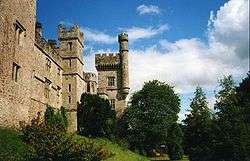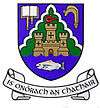Lismore, County Waterford
| Lismore Lios Mór | ||
|---|---|---|
| Town | ||
|
Lismore Castle | ||
| ||
 Lismore Location in Ireland | ||
| Coordinates: 52°08′12″N 7°55′51″W / 52.1367°N 7.9308°WCoordinates: 52°08′12″N 7°55′51″W / 52.1367°N 7.9308°W | ||
| Country | Ireland | |
| Province | Munster | |
| County | Waterford | |
| Elevation | 86 m (282 ft) | |
| Population (2006) | ||
| • Urban | 790 | |
| • Rural | 450 | |
| Time zone | WET (UTC+0) | |
| • Summer (DST) | IST (WEST) (UTC-1) | |
| Irish Grid Reference | X045984 | |
| Historical population | ||
|---|---|---|
| Year | Pop. | ±% |
| 1813 | 1,569 | — |
| 1821 | 2,330 | +48.5% |
| 1831 | 2,894 | +24.2% |
| 1841 | 3,007 | +3.9% |
| 1851 | 2,319 | −22.9% |
| 1861 | 2,085 | −10.1% |
| 1871 | 1,946 | −6.7% |
| 1881 | 1,860 | −4.4% |
| 1891 | 1,632 | −12.3% |
| 1901 | 1,583 | −3.0% |
| 1911 | 1,474 | −6.9% |
| 1926 | 1,363 | −7.5% |
| 1936 | 1,194 | −12.4% |
| 1946 | 1,174 | −1.7% |
| 1951 | 1,089 | −7.2% |
| 1956 | 893 | −18.0% |
| 1961 | 1,069 | +19.7% |
| 1966 | 1,046 | −2.2% |
| 1971 | 1,041 | −0.5% |
| 1981 | 1,119 | +7.5% |
| 1986 | 1,085 | −3.0% |
| 1991 | 1,095 | +0.9% |
| 1996 | 1,095 | +0.0% |
| 2002 | 1,182 | +7.9% |
| 2006 | 1,240 | +4.9% |
| 2011 | 1,369 | +10.4% |
| [1] | ||
Lismore (Irish: Lios Mór, meaning "great ringfort") is an historic town in County Waterford, in the province of Munster, Ireland.
Location
Lismore is located in the west of County Waterford, where the N72 road crosses the River Blackwater at the foot of the Knockmealdown Mountains (Irish: Sléibhte Chnoc Mhaoldomhnaigh), the mountain range which divides the counties of Tipperary and Waterford.
Transport
Bus transport
Since December 2015 significant improvements to the frequency of the Local Link (formerly known as Déise Link) bus service are in effect. A bus shelter has also been provided in the town. There are now four services a day each way Mondays to Saturdays inclusive to Dungarvan via Cappoquin including a commuter service. Connections to Waterford and Rosslare Europort can be made at Dungarvan. In the other direction there are four services to and from Tallow where connections can be made for Fermoy.[2] On Saturdays a local bus company operate a service to Cork. On Sundays Bus Éireann route 366 links Lismore to Dungarvan and Waterford. This route only operates on Sundays and comprises a single journey in one direction (no return service on any day of the week).[3]
Rail
Lismore formerly had a rail station on the now dismantled Waterford to Mallow line and was served by the Cork to Rosslare boat train. The line and station closed in 1967 though the station is still extant.[4]
History
Founded by Saint Mochuda (Irish: Mo Chutu mac Fínaill), died 637, also known as Saint Carthage (Carthach or Carthach the Younger; Latinised: Carthagus, Anglicised: Carthage), first abbot of Lismore (Irish: Les Mór Mo Chutu). The town is renowned for its early ecclesiastical history and the scholarship of Lismore Abbey.
The imposing Lismore Castle, situated on the site of the old monastery since medieval times, lies on a steep hill overlooking the town and the Blackwater valley. It can trace an eight-hundred-year-old history linking the varied historic relations between England and Ireland. Originally built following the arrival of Henry II's son, Prince John, in the twelfth century, the castle was a bishop's palace up to the sixteenth century. Subsequently owned by Sir Walter Raleigh until his demise, it was sold to Richard Boyle, controversial First Earl of Cork, described by historian R. F. Foster, in his Modern Ireland, as an "epitome of Elizabethan adventurer-colonist in Ireland". In 1627 the castle was the birthplace of the First Earl's most famous son, Robert Boyle (of Boyle's Law), known as the "Father of Modern Chemistry". Boyle was chased off his lands in Ireland during the Irish Rebellion of 1641, following which his sons recovered the family estates after suppression of the rebellion. The castle remained in the possession of the Boyle family until it passed to the English Dukes of Devonshire in 1753 when the daughter of the 4th Earl of Cork, Lady Charlotte Boyle, married William Cavendish, 4th Duke of Devonshire, a future Prime Minister of Great Britain and Ireland.
The Book of Lismore (original name: Leabhar Mhic Cárthaigh Riabhaigh meaning The Book of Mac Cárthaigh Riabhach), a compilation of medieval Irish manuscripts mainly relating the lives of Irish saints, notably St Brigid, St Patrick, and St Columba, also contains Acallam na Senórach, a most important Middle Irish narrative dating to the 12th century, pertaining to the Fenian Cycle. The Book of Lismore and the Lismore Crozier (an enclosure for an episcopal staff, believed to be the venerable oaken staff of the founder of the abbey), were discovered together in 1814 behind a blocked-up doorway in Lismore Castle. Today the castle continues in the private ownership of the Dukes of Devonshire who open the gardens and parts of the grounds for public access via a changing programme of local arts and education events. The Book of Lismore is on display at Chatsworth House in Derbyshire, England and the Lismore Crozier is in the National Museum of Ireland in Dublin.
The medieval Lismore Cathedral, dedicated to St Carthage, variously damaged and repaired over the centuries, is notable for its architecture and the stained glass window by the English pre Raphaelite artist, Edward Burne-Jones.
A plaque has been erected in the town to commemorate the regular visits made to Lismore by Fred Astaire following an association developed by his sister, Adele Astaire, who was married to Lord Charles Arthur Francis Cavendish, son of Victor Cavendish, 9th Duke of Devonshire. A notable resident born in the town who has described her early life in Lismore, is the internationally renowned travel writer and world touring cyclist, Dervla Murphy. Another notable resident was George O'Brien award-winning Irish memoirist, writer, and academic, who was raised by his paternal grandmother in Lismore, described in his memoir The Village of Longing: An Irish Boyhood in the Fifties (1987).
Annalistic references
See Annals of Inisfallen.
- AI701.1 Kl. Repose of Cúánna of Les Mór.
- AI707.1 Kl. Conodur of Les Mór rested.
- AI730.1 Kl. Repose of Colmán grandson of Lítán, abbot of Les Mór.
- AI752.3 Repose of Mac Uige, abbot of Les Mór.
- AI760.1 Kl. Tríchmech, abbot of Les Mór, rested, and Abnér, abbot of Imlech Ibuir.
- AI763.1 Kl. Repose of Rónán, bishop of Les Mór.
- AI768.1 Kl. Aedan, abbot of Les Mór, rested.
- AI774.2 Suairlech, abbot of Les Mór, [rested].
- AI778.2 Repose of Airdmesach of Les Mór.
- AI783.3 Repose of Suairlech Ua Tipraiti in Les Mór.
- AI794.4 Violation(?) of the Rule of Les Mór in the reign of Aedán Derg.
- AI814.1 Kl. Repose of Aedán moccu Raichlich, abbot of Les Mór.
- AI814.2 The abbacy of Les Mór to Flann, son of Fairchellach.
- AI818.2 The shrine of Mochta of Lugmad in flight before Aed,son of Niall, and it came to Les Mór.
- AI825.1 Kl. Repose of Flann son of Fairchellach, abbot of Les Mór, Imlech Ibuir, and Corcach.
- AI833.1 Kl. Les Mór Mo-Chutu and Cell Mo-Laise plundered by the heathens.
- AI867.1 Kl. Amlaíb committed treachery against Les Mór, and Martan was liberated from him.
- AI883.1 Kl. The burning of Les Mór by the son of lmar.
- AI912.1 Kl. Repose of Mael Brigte son of Mael Domnaig, abbot of Les Mór.
- AI920.1 Kl. The martyrdom of Cormac son of Cuilennán, bishop and vice-abbot of Les Mór, abbot of Cell Mo-Laise,king of the Déisi, and chief counsellor of Mumu, at the hands of the Uí Fhothaid Aiched.
- AI938.1 Kl. Repose of Ciarán son of Ciarmacán, abbot of Les Mór Mo-Chutu.
- AI947.1 Kl. A leaf [descended] from heaven upon the altar of Imlech Ibuir, and a bird spoke to the people; and many other marvels this year; and Blácair, king of the foreigners, was killed.
- AI953.2 Repose of Diarmait, abbot of Les Mór.
- AI954.3 Diarmait son of Torpaid, abbot of Les Mór, [rested].
- AI958.3 Repose of Cinaed Ua Con Minn, bishop of Les Mór and Inis Cathaig.
- AI959.2 Repose of Maenach son of Cormac, abbot of Les Mór.
- AI983.3 Repose of Cormac son of Mael Ciarain, abbot of Les Mór.
- AI1024.3 Repose of Ua Maíl Shluaig, coarb of Mo-Chutu.
Gallery
 Lismore town centre
Lismore town centre Memorial plaque honouring Fred Astaire on the wall of Madden's Summerhouse Cafe.
Memorial plaque honouring Fred Astaire on the wall of Madden's Summerhouse Cafe.- William M. Thackeray plaque on the wall of the Lismore House Hotel, Main Street.
People
The following people were born in Lismore.
- Robert Boyle (born 1627, died 1691) - Famous physicist and chemist.
- William Henry Grattan Flood (born 1859, died 1928 in Enniscorthy, County Wexford) - Noted author, composer, musicologist and historian.
- Dervla Murphy (born 1931) - Travel writer.
International relations
Twin towns — Sister cities
Lismore is twinned with the city of Lismore, New South Wales, in Australia.
See also
References
- ↑ and Histpop.org, Figures post 1961 are for Lismore and environs. For a discussion on the accuracy of pre-famine census returns see JJ Lee “On the accuracy of the pre-famine Irish censuses” in Irish Population, Economy and Society edited by JM Goldstrom and LA Clarkson (1981) p54, and also “New Developments in Irish Population History, 1700-1850” by Joel Mokyr and Cormac Ó Gráda in The Economic History Review, New Series, Vol. 37, No. 4 (Nov., 1984), pp. 473-488.
- ↑ http://www.locallinkwaterford.ie/whocanusedeiselink.shtml
- ↑ "Archived copy" (PDF). Archived from the original (PDF) on 2012-10-25. Retrieved 2013-05-03.
- ↑ http://eiretrains.com/Photo_Gallery/Railway%20Stations%20L/Lismore/IrishRailwayStations.html
External links
| Wikimedia Commons has media related to Lismore, County Waterford. |
- Lismore Tourist Office
- Lismore Music Festival
- Lismore Development Company
- Interview with Duke of Devonshire who resides in Lismore Castle
- Lismore Immrama Festival Of Travel Writing
- The Tidy Towns of Ireland "Celebrating 50 years"


